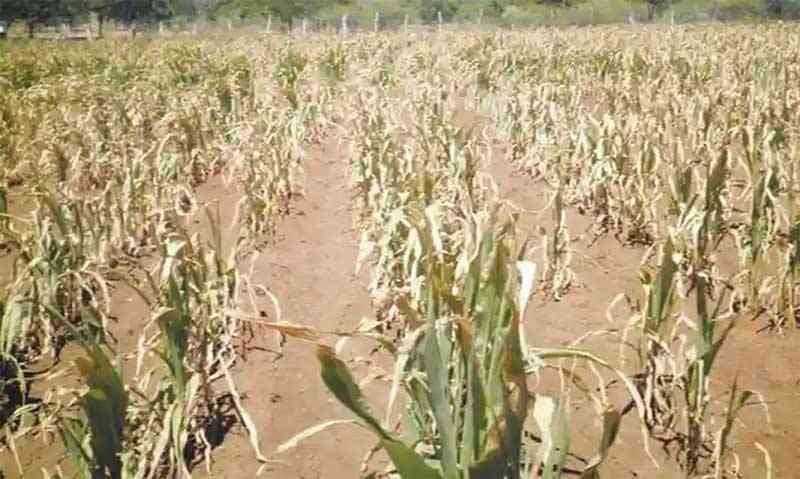
SAVE VALLEY — In the sweltering Lowveld heat, Jenny Zimuhunwe magnetically combs the ground, picking up sorghum grains, making sure nothing would goes to waste.
BY TATENDA CHITAGU
At the same time, she jealously guards her sack of the food ration given to her and many other villagers courtesy of the World Food Program (WFP) last week at Mupinga Primary School under Chief Tshovani in Chiredzi East.
“I cannot afford to leave even the last grain. I have been surviving on porridge from baobab fruits. On lucky days, I only have one decent meal,” says the elderly woman who hardly remembers her age.
“I look after my four grandchildren whose parents are deceased and I have no source of income. This is a timely boost for us.”
She said sometimes well-wishers donate the staple maize grain to them while at other times she borrows from fellow villagers.
“I’m glad that I benefited from the food aid. There is a huge food deficit at home. I also owe some villagers foodstuffs which I have not repaid. I pray that they may increase the ration next time,” she continues.
“I did not harvest anything last year owing to the drought and besides, I borrow cattle for draught power and people may lend you their cattle when the moisture is gone.”
- Chamisa under fire over US$120K donation
- Mavhunga puts DeMbare into Chibuku quarterfinals
- Pension funds bet on Cabora Bassa oilfields
- Councils defy govt fire tender directive
Keep Reading
The protective ration, given through WFP’s implementing partner, Plan International, consisted of 6kg of sorghum or sometimes maize, 2kg of beans and 800ml of cooking oil.
Elsewhere at the food distribution point, Martha Lesongo (34), from Manyuke Village, could be seen weeping after her name was left out from the list of beneficiaries. She even pestered journalists present, thinking they were from WFP.
“I did not get aid today. Please consider me for next time. I have literally nothing. The situation is bad for everyone here,” she sobs.
Plan International national food aid manager Titus Mufemba said they considered very high food-insecure families for the aid, which he said was limited because of scarce resources from the donor community.
Mufemba said 22 885 families from Chiredzi district are set to benefit up to December. “In January to March, considered the highest food deficit period, we are set to increase the beneficiaries to 30 000. We also hope that the aid will be increased if other donors come on board.
“The food rations were cut because of limited funding. There are many nations in need of relief at the moment in Africa and elsewhere, but it is better that every country in crisis gets something. Half a loaf is better than nothing,” he said. The area falls under natural regions 5 and 6 and is not suitable for maize. Only drought-tolerant crops like sorghum may do the trick.
Ignorance on growing small grains
Despite having their crops fail even in better seasons, farmers in the area still cling on to growing the staple maize and shun small grains, the councillor for the area, Munyengeri Murawu, disclosed.
Murawu, who has been councillor since 2002, said farmers not only lack education on the need to shift to small grains, but fall short of inputs and draught power while facing the real prospect of having their sorghum destroyed by quelea birds.
“We once had sorghum contract farming which was sponsored by a local brewer. All the sorghum was eaten by the birds and people had problems repaying the loan. Weevils also ate the grains. They resorted back to growing maize,” he said.
“Locals also consider small grains as labour intensive than maize from farming up to grinding. For sorghum, you have to pound it before going to the grinding mill so people stick to maize even though it fails year in year out.”
He also bemoaned low hectarage allocated to farmers in the area.
“While others in neighbouring areas have 10 to 15 hectares, here each farmer has two to three hectares, and this means less production and less yields,” Murawu said.
Migration to South Africa, Mozambique
Chief Tshovani, also known as Felix Mundau, said hunger and lack of employment opportunities in the area had forced many young boys and men to migrate to neighbouring South Africa and Mozambique in search of the proverbial greener pastures.
“Hunger is severe here. It has forced many able-bodied men to migrate. If you go to the schools, you will find that the enrolment is tilted in favour of girls. Most boys, once they are able to read and write, migrate to neighbouring countries,” he said.
“The situation is now better because of the fall of the South African rand, as some are trickling back while it is also a deterrent to would-be migrators.”
Thousands of villagers in some parts of Masvingo province that have been hard-hit by the drought are being forced to sell off priced livestock to feed their families as hunger stalks the drought-prone region.
The WFP recently announced that about 1,5 million Zimbabweans need urgent food aid due to the famine.











